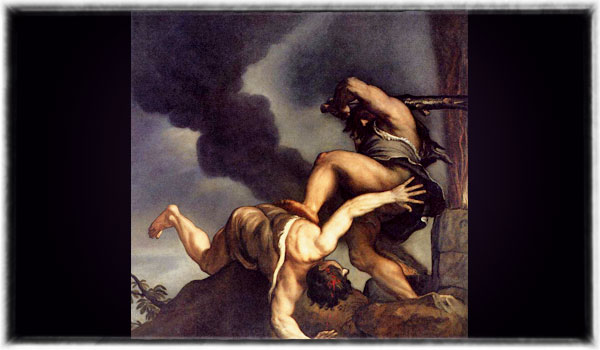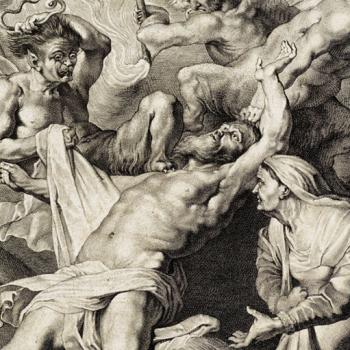
In this article, I am delivering on the promise I made in my previous entry that I would explore the mimetic theory of René Girard.
The reason I’m doing this is simple: Girard’s theory is paramount in addressing the violence that grips our world and, at a time such as this–when bombs and bullets have become the paradoxical default answers for solving the problem of bombs and bullets–we need a better solution. In medicine, a disease can’t be properly treated without the correct diagnosis. Likewise, we can’t begin to address the problem of violence unless we understand its root cause.
So, let’s get started, shall we?
The key to unlocking our problem of violence is to understand that our desires are non-consciously derived from the desires of others–and vice-versa. I’m oversimplifying, but we are all copycats of each other, modeling for one another what objects should be deemed the most desirable. This might be hard to accept here in the West, where autonomy is king, but it is nevertheless true. If our desires were not influenced by the desires of others, and were instead fixed and static, they would simply be a form of instinct (Girard, I See Satan Fall like Lightning, 15). Hopefully we recognize that we are beings who possess something more than mere instinct–that we have a free will of sorts, even if that will does suffer from enslavement.
This enslavement is evident throughout our world. Pay attention to the fashion industry, which uses celebrities and other attractive and powerful people to model their clothing. They do so hoping that we will all desire their brand simply because those we look up to desire that brand (or so we tell ourselves). And you know what? It works! Why? Because our desires are mimetic, a non-conscious imitation of those we take on as models. For another example, ask yourself what happens when two children are in a room full of toys. More often than not, they will end up fighting over a single toy. It doesn’t really matter which toy, either, as conflict comes to fruition as soon as one child shows interest in a particular toy, and the other child, via mimetic desire, wants that same toy.
This is the point of the Decalogue’s tenth commandment. When the writer says “thou shalt not covet”–or in other words, desire, as the Hebrew word chamad can mean either–he is speaking to a fundamental human problem. Notice how the commandment is laid out in Exodus 20:17. After going through all the objects we are to avoid desiring, the writer seems to give up, conceding that what needs prohibiting is whatever belongs to the neighbor. It doesn’t matter what the object is. It is the neighbor’s ownership that powerfully gives the objects their desirable effect.
Yet, to this day, we continue to engage in the very mimetic conflicts this commandment is addressing. We do this, not only because it is simply who we are, but because prohibitions do not really work at quelling violence. In fact, they are like the Greek word pharmakon: both the poison and the cure. Think about what happens when people are told not to push the “red button,” or, when Adam and Eve are commanded not to eat of the fruit of a certain tree.
Because making something taboo is not the end-all-be-all solution to repressing violence, we continue in our violent ways. So much so that, throughout history, entire societies and civilizations have wiped themselves out through violent in-fighting, cannibalized out of existence. But not all of them–why?
Human societies are like a pressure-cooker. Some have faulty release valves, and so will eventually violently explode. But others have a perfectly functioning pressure release valve. What is this mechanism for relieving the pressure of societal violence? In a word: scapegoating.
When societal violence escalates to the point of spiraling out of control, people turn to a surrogate victim to place their hostility upon. In doing this, they unify against this enemy “other.” We witnessed this in 2011, after Osama Bin Laden was killed. A nation divided along party lines–Democrat Blue and Republican Red–powerfully came together in the city streets to sing the national anthem and “God Bless America.” Why? Because Bin Laden was like a virus, a plague, the face of evil, he was the entire Western world’s persona non grata, public enemy number one. This, we could all agree on! So, through the scapegoating of Bin Laden, a nation divided became, at least for a brief moment in time, a nation united.
When we think about archaic societies, then, it is easy to imagine how this process of unification was believed to be divinely mandated. If the plague our civilization is under is lifted after we murder or expel a victim or victims, how could we not think this violence was the will of the gods? In the Oedipus myth, the Apollonian plague is not lifted until after King Oedipus is expelled from Thebes. Similarly, in Numbers 25, God plagues the Israelites because some of the people were getting down and dirty with the Moabites. So, like any good zealot, Aaron’s grandson, Phinehas, murders, in cold blood, an Israelite man and Moabite woman, thus lifting the plague (Num 25:8).
As Girard noticed, this is the theme of many of humanity’s myths, because, as the saying goes, “dead men tell no tales.” To that end, what we have historically done is paper over the truth of our victimizing by claiming our violence is sacred, while those whom we have victimized remain forever silenced, six feet under, or at minimum, far removed from society.
In order to keep peace going as long as we can, we then ritualize this process of societal bloodletting, giving birth to the altar of sacrifice. It is here we return whenever we believe the gods need placating. And in our most ancient societies, there was a lot of placating to do. As late as the 15th century, the Aztecs were performing up to 80,000 human sacrifices in a single four-day ritual (Hassig, Ross. “El Sacrificio y las querras floridas.” Arqueología Mexicana 63, p47). Yikes!
This is why Jesus Christ’s command to follow him is so crucial. Because we cannot simply turn off our desires like an “on/off” switch, we have to instead look to a model to help us with the fundamental human problem of desire-driven violence. That model is Christ, the one who renounced entering into negative mimetic rivalries, who instead offered himself as a model of positive mimesis. That is what is meant by his claims that “the Son can do nothing on his own, but only what he sees the Father doing,” “I have come down from heaven, not to do my own will, but the will of him who sent me,” “I do nothing on my own, but I speak these things as the Father instructed me,” “the Father and I are one,” and “I have not spoken on my own, but the Father who sent me has himself given me a commandment about what to say and what to speak” (John 5:19; 6:38; 8:28; 10:30; 12:49).
So, it is sort of like a chain–from the Father to Jesus and then from Jesus to us–Jesus reveals both the heart of God as well as what being truly human is all about. And really, the heart of God is reflected in Jesus’ being truly human, which he defines when he refers to himself as “the son of man, who came not to be served but to serve” (Mark 10:45—my paraphrase). Thus, we have the ability to follow in serving others, in giving away ourselves for the other. Or, as James Alison puts it, “The Father wants us to see himself in Jesus so that we may start to build a new humanity from the victim, rather than over against victims as we continually do” (Alison, Knowing Jesus, 112).
The crux of the Girardian understanding of the Gospel is this: God made us to desire what others desire so that he could have relationships with self-conscious beings, so that we could desire what God desires. He did this by becoming flesh (John 1:14)—one of us—to be our model for positive mimesis. He did this because he loves us. God is love (1 John 4:8). And in love, he gives us the ultimate theological-anthropological revelation (Tony Bartlett’s term). Without mimesis, none of this could happen.
Even though our mimetic desires do tragically lead to human violence, without them relationship between the divine and humanity would be thwarted. Hence, we can agree with Girard and say that it is not a bad thing per se, but actually good (Girard, I See Satan, 15). We just need to understand it much better than we currently do, which is what this little primer is all about.
If you would like to enrich your understanding of mimetic theory, please check out my new book, From the Blood of Abel: Humanity’s Root Causes of Violence and the Bible’s Theological-Anthropological Solution, which comes out today from Quoir Publishing.
Peace.
 About Matthew Distefano
About Matthew Distefano
Matthew Distefano is the author of All Set Free: How God is Revealed in Jesus and Why That is Really Good News and the newly-released From the Blood of Abel. He is also a Regular Contributor for The Raven ReView and ProgressiveChristianity.org. You can find him on his website, Facebook, and Twitter.












